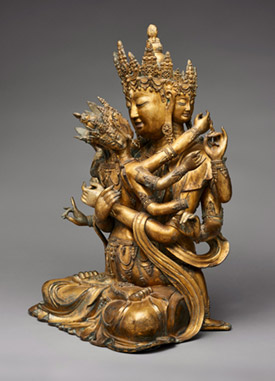Divine Bodies
Asian Art Museum. San FranciscoMarch 9 through July 29, 2018
all text & images © Asianart.com and The Asian Art Museum except as where otherwise noted

The Buddhist deity Guhyasamaja, approx. 1400–1500
China; Beijing, Ming dynasty (1368–1644).
Bronze with gilding.
Asian Art Museum, The Avery Brundage Collection, B64B23.
Photograph © Asian Art Museum. The exhibition of Divine Bodies, on view at the Asian Art Museum from March 9 through July 29, 2018, showcased historical sculpture from Buddhist and Hindu traditions along with contemporary photo-based work from renowned Indian artists. While this feature on asianart.com presents a selection of fifteen of the fine Buddhist and Hindu sculpture from the Asian’s superb collections, this brief introduction will highlight the other features of this complex exhibition.
The human form in art has always helped shape how we answer life’s biggest questions:
Where do we come from?
Why are we here?
Who are we?
What happens when we die?
In response, the Asian Art Museum presented Divine Bodies, bringing together nearly 70 large-scale historical sculptures and paintings from Hindu and Buddhist traditions, along with contemporary photo-based work. This original exhibition invited us to dwell on these mysteries as we ponder the power of transformation, the possibility of transcendence, and the relationship of our bodies to the cosmos.
“Divine Bodies presents masterpieces from 1500 years ago to today, from what is now India, Pakistan, and the wider Buddhist world, to engage visitors in a real conversation,” explained Qamar Adamjee, the museum’s Malavalli Family Foundation Associate Curator of Art of the Indian Subcontinent. “These artworks demand that we contemplate our role in a larger cosmology by asking, ‘How we can see the human in the divine and the divine in the human?’”
Artists from across Asia have long depicted deities — Hindu gods and goddesses, Buddhas and bodhisattvas, from the gentle to the fierce— in carnal human form. Their familiar facial features and unexpectedly corporeal figures allow mortals to relate to immortals, establishing an ongoing interaction between human and divine bodies: between material and ethereal, physical and metaphysical, finite and infinite.
“The idea is that by contemplating physical beauty, devotees experience the metaphysical beauty behind such images,” said exhibition co-organizer Jeff Durham, Assistant Curator of Himalayan Art, and a practicing yoga instructor. “A statue is not just a statue: the exhibition encourages us to look at these artworks as devotional images imbued with real divine potency and reminds us of our own spiritual agency on the path to enlightenment.”
In addition to traditional depictions of sacred forces, Divine Bodies also presented four series from contemporary Indian photographers — Gauri Gill, Dayanita Singh, Pamela Singh, and Vivan Sundaram — as well as video work from American-Korean duo David and Hi-Jin Hodge. An extensive presentation of photography for the Asian Art Museum, these works together addressed an issue central to the exhibition: How can we discover meaning in an ever-changing, impermanent world?
These award-winning photographers are widely celebrated in their home country. From deeply personal stills of 20th-century graves, to images of temples and worshippers wittily reworked with pen and ink, the mostly black and white selection of photographs provides a familiar foothold to explore the rich theology underlying Divine Bodies.
In the most well-known series, Myself Mona Ahmed (1999–2017), photographer Dayanita Singh documents the life of a “eunuch” and member of Delhi’s hijra community. Born male and self-identified as female, hijra are considered a third sex in India and are simultaneously shunned and revered as close to the divine, capable of containing — like several important Hindu deities on view in Divine Bodies — both male and female cosmic forces.
 Mona and Myself (still), 2013, by Dayanita Singh (Indian, b. 1961). Single-channel video with sound. Courtesy the artist Frith Street Gallery, London. © Dayanita Singh. |
By putting the human at the center of the exhibition as much as the artwork on view, Divine Bodies invited visitors to draw connections to their own lives and inspires personal interpretations.
“Viewing divine bodies from China, India, Thailand, Tibet, Indonesia, Pakistan and other regions side by side reveals truly universal themes as well as culturally specific ideals of beauty and godliness,” said Asian Art Museum director and CEO, Jay Xu. “You don’t have to be an adherent of these faith traditions to grasp the power and meaning of these incredible devotional artworks.”
The Asian Art Museum was the only venue for Divine Bodies.
The catalogue of the exhibition can be ordered at https://amzn.to/2AWEvK1
Back to main exhibition
asianart.com | exhibitions